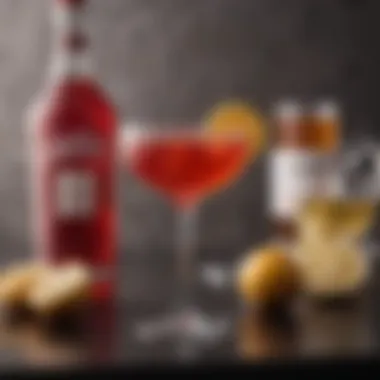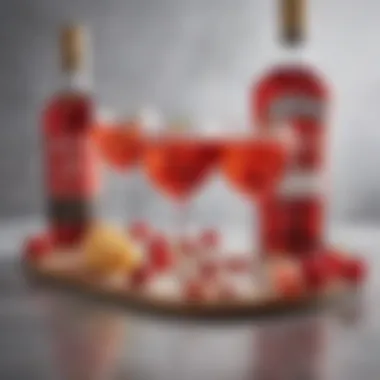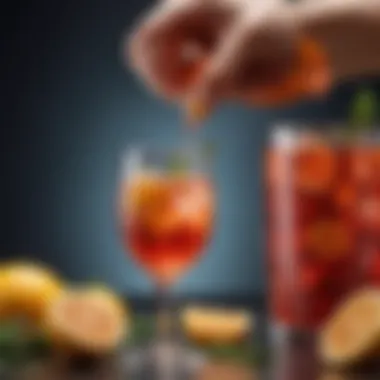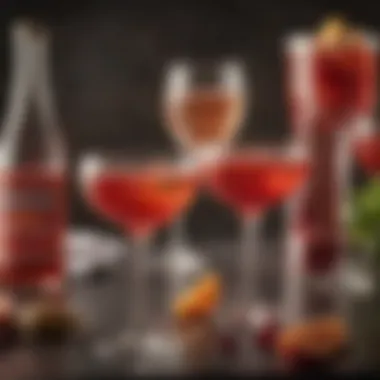A Comprehensive Exploration of the Campari Champagne Cocktail


Intro
The Campari Champagne cocktail is a sophisticated blend that marries the bitter complexity of Campari with the effervescent charm of Champagne. This drink is not just a beverage; it embodies a certain lifestyle and an appreciation for the finer things in life. It stands as a symbol of conviviality and celebration, appealing to both casual drinkers and dedicated mixologists alike. Understanding its components and preparation methods can elevate the experience of indulging in this cocktail.
Recipe Overview
The Campari Champagne cocktail combines the unmistakable flavor of Campari with smooth Champagne, creating a unique taste sensation. The drink is typically served in a flute glass, showcasing its refreshing bubbles while allowing the rich red hue from Campari to shine through. This cocktail is perfect for festive gatherings or quiet evenings alike.
Ingredients list
- 1 part Campari
- 3 parts Champagne
- Orange twist or slice for garnish
- Optional: Sugar syrup for sweetness
Step-by-Step Cooking Instructions
To prepare the Campari Champagne cocktail, follow these straightforward steps:
- Chill the Champagne:
Ensure that the Champagne is thoroughly chilled before starting. This enhances the refreshing quality of the cocktail. - Measure the Ingredients:
Pour one part Campari into a mixing glass. Following this, add three parts of Champagne carefully to preserve the bubbles. - Mix Gently:
Stir gently to combine the flavors. Avoid vigorous shaking, as this may lead to a loss of carbonation. - Garnish:
Add a twist or slice of orange to the drink. This adds a pleasant aroma and a hint of citrus that complements the bitterness of Campari. - Serve:
Pour the mixture into a chilled flute glass and serve immediately.
The Campari Champagne cocktail showcases the balance of bitter and bubbly, making it a delightful choice for any occasion.
Useful tips for each step
- Chilling the Champagne: Use an ice bucket for rapid chilling, or place the bottle in the freezer for 15 minutes.
- Choosing the Champagne: Opt for a dry Champagne to enhance the flavor balance. Brands like Moët & Chandon or Veuve Clicquot work well.
- Garnishing Technique: Use a vegetable peeler for a clean twist of orange to maximize visual appeal and flavor.
By following these methods, one can create an exquisite Campari Champagne cocktail. It is not just about mixing; it involves understanding how the ingredients interact, which further enhances the drinking experience.
Foreword to the Campari Champagne Cocktail
The Campari Champagne cocktail embodies a sophisticated fusion of flavors and cultures. This cocktail not only impresses with its taste but also carries a rich history that enhances its appeal. Understanding the nuances of this drink is essential for any culinary enthusiast or mixologist seeking to expand their repertoire. The cocktail showcases how two distinct elements can come together, creating a refreshing yet complex drink. It becomes relevant in discussions of contemporary cocktail culture, as we see a resurgence of classic beverages like this one. Delving into the origins, ingredients, and preparation methods provides insight into why this cocktail stands out in the realm of mixology.
Understanding the Ingredients
The Campari Champagne cocktail primarily consists of two main ingredients: Campari and Champagne. Campari is an Italian bitter that offers a vibrant red hue and a unique blend of flavors. Its bitter notes balance perfectly with the sweetness found in many champagnes. This depth and contrast create a cocktail that is both refreshing and intriguing.
In choosing the right Champagne, factors like dryness and flavor profile come into play. A brut or extra brut Champagne typically works best, as its effervescence contrasts nicely with the bitterness of Campari. Additionally, garnishes such as citrus twists or herbs can enhance the experience, adding layers to the flavor profile.
The Historical Context
The origin of the Campari Champagne cocktail traces back to Italy, where Campari was created in 1860 by Gaspare Campari. It became a staple in Italian bitters and aperitifs. Champagne, revered in French culture, has long been associated with celebrations and luxury. Over time, the combination of these two iconic drinks evolved, gaining popularity in bars and homes alike.
This cocktail reflects more than just ingredients; it is a history lesson in taste preferences and cultural exchanges. The thriving cocktail scene today has seen a resurgence in interest in classic drinks, with the Campari Champagne cocktail often highlighted as a prime example of tradition and innovation in the modern bar.
"Drinks like the Campari Champagne cocktail serve as a bridge connecting gastronomic styles and histories, making them significant beyond their ingredients."
Understanding these elements will prepare the reader for the deeper exploration of taste and technique that follows.
Flavor Profile of the Cocktail
The flavor profile of the Campari Champagne cocktail is an essential aspect that encompasses both the complexity of its ingredients and the experience of consuming it. Understanding these flavors is crucial for anyone interested in mixology or culinary exploration. This section delves into the harmonious yet contrasting components of Campari and Champagne, which when combined, create a unique tasting experience. The interaction between the bitter notes of Campari and the effervescent qualities of Champagne delivers a balance that can intrigue beverage enthusiasts and casual drinkers alike.


The Bitter Complexity of Campari
Campari, a quintessential Italian bitter, is the heart of this cocktail. Its flavor is notably complex, featuring a blend of herbs, spices, and fruits. The bitterness comes from a secret recipe of natural ingredients that are infused in alcohol. This bitterness is not just an isolated characteristic but a vital element that interacts with other components in the cocktail.
The bitterness in Campari plays a critical role in balancing sweetness from any added elements, allowing for a more nuanced flavor profile. It is important to understand that bitterness can enhance the overall tasting experience by provoking the palate, encouraging one to appreciate the subtleties in the drink. Additionally, the layers in Campari can evoke discussions around its various characteristics, such as herbal notes, hints of citrus, and the deep red color that adds to its visual appeal.
The Effervescence of Champagne
On the other end of the flavor spectrum is Champagne, celebrated for its effervescence. The bubbles in Champagne create a refreshing tactile experience, which complements the dense flavors of Campari. This effervescence stimulates the senses, making each sip invigorating while also lightening the overall profile of the cocktail.
Champagne's acidity also deserves mention. This tartness contrasts beautifully with the bitter notes of Campari, producing a dynamic flavor interaction. When one sips the Campari Champagne cocktail, the bubbles dance on the tongue, while the Campari's bitterness lingers, creating a multi-layered drinking experience. Together, these two ingredients form a symbiotic relationship that draws the drinker back for another sip.
"The balance of bitter and bubbly is what makes the Campari Champagne cocktail so interesting and enjoyable."
Preparation Techniques
Preparation techniques are essential in crafting the Campari Champagne cocktail. This section will emphasize the processes involved, their impact on flavor development, and the overall presentation of the drink. Proper mixing, choosing the right glassware, and garnishing are vital to achieving the intended experience and enjoyment of the cocktail.
Mixing the Ingredients
Mixing the ingredients forms the backbone of this cocktail's successful creation. To start, it is important to use a high-quality Campari and a preferred Champagne. The bitter notes of Campari should blend seamlessly with the crispness of Champagne. A typical method is to pour Campari into a shaker with ice, giving it a good shake. This releases more flavors from the Campari. After mixing, the cocktail is poured gently into the glass, enabling the Champagne to flow softly, preserving its effervescence. The ratio of Campari to Champagne can vary based on personal taste, with a common balance being one part Campari to three parts Champagne. This balance can be adjusted as needed, depending on how pronounced one wants the bitterness or the brightness of the Champagne.
Glassware Selection
The choice of glassware significantly enhances the experience of the Campari Champagne cocktail. A flute or coupe glass is recommended as they highlight the cocktail's elegant appearance. Flutes retain bubbles longer, while coupes offer a wide mouth, encouraging aroma release. When selecting the glass, consider its size and shape. A narrower flute will concentrate the aroma and maintain carbonation, whereas a wider coupe allows for more aroma accessibility. Above all, ensure that the glass is well-chilled. This small detail can elevate the drinking experience by keeping the cocktail crisp and refreshing.
Garnishing the Cocktail
Garnishing adds the final touch that can elevate a cocktail from simple to remarkable. For the Campari Champagne cocktail, the classic garnish is an orange twist or slice. The bright color complements the vivid red of the Campari. The oils released from the peel enhance the drink’s aromatic profile. It is also common to use a maraschino cherry, which adds a sweet contrast to the bitterness of Campari. When garnishing, aim for simplicity, as an overly complex garnish can detract from the cocktail's elegant charm. Remember, the presentation should reflect the cocktail's sophistication and attention to detail.
The techniques involved in preparing the Campari Champagne cocktail not only influence the drink's taste but also enhance the overall experience for those enjoying it.
Variations of the Campari Champagne Cocktail
The Campari Champagne cocktail, while sophisticated in its standard form, opens the door to a myriad of variations that can cater to diverse tastes and occasions. These adaptations provide a unique way to personalize the drink, enhancing not just the flavor but also the overall experience. Variations can highlight seasonal ingredients, different flavor profiles, or even aesthetic preferences. Each twist allows both novice and experienced mixologists to explore their creativity while staying true to the essence of the cocktail. Exploring variations enables us to appreciate the versatility of the ingredients, particularly Campari and Champagne, which can blend with various flavors seamlessly.
Fruit-Infused Variations
Fruit-infused variations of the Campari Champagne cocktail introduce a vibrant freshness that complements the bitterness of Campari. Some popular fruits for infusion include
- Peach: The sweetness balances the bitter notes.
- Raspberry: Adds a tart contrast, creating a delightful complexity.
- Strawberry: Offers a classic pairing with Champagne.
When creating a fruit-infused variation, purée the fruit of choice and strain it to achieve a smooth texture. Incorporate the purée into the mixing process, adjusting the amount based on desired sweetness. For example, a Peach Campari Champagne can be prepared by blending equal parts of puréed fresh peaches with Campari, topped with chilled Champagne for a refreshing twist.
This kind of adaptation can not only enhance the visual appeal of the drink but also introduce a beautiful aroma, making the experience multisensory. The timing of fruit selection can also play a significant role; seasonal fruits often yield the best flavors, making these variations not only a delicious choice but a thoughtful one as well.
Herb-Enhanced Versions
Herb-enhanced versions of the Campari Champagne cocktail can offer an intriguing depth of flavor. Using fresh herbs creates a sophisticated herbal note that contrasts with the drink's bitterness. Some popular herbs to consider include
- Basil: Provides a fresh and fragrant quality.
- Mint: Refreshing and brightens the palate.
- Thyme: Adds warmth and earthiness.


To create an herb-enhanced cocktail, gently muddle the selected herb at the bottom of the glass before adding the other ingredients. For example, the Basil Campari Champagne involves muddling fresh basil leaves with a little sugar to coax out the herb's essence. Add ice, Campari, and Champagne, stirring gently to combine. This method preserves the herb's fragrance while allowing it to infuse the drink subtly.
Each herb brings its flavor profile, and experimenting with different combinations can yield surprising results. Not only do these variations enhance flavor, but they also elevate the drink's aesthetic with vibrant colors and textures.
"A great cocktail is a balance of flavors, and variations add an exciting dimension to the Campari Champagne experience."
By exploring these variations, one can extend the enjoyment of the Campari Champagne cocktail beyond its classic rendition, tailoring it for multiple occasions and personal preferences.
Cultural Significance
The Campari Champagne cocktail not only represents a fusion of two celebrated beverages but also reflects deeper cultural themes. The interplay of Campari, an Italian bitter, and Champagne, a French sparkling wine, illustrates the interconnectedness of culinary traditions across borders. This cocktail serves as an excellent example of how two cultures can blend their distinct flavors while maintaining their unique identities. As such, it invites enthusiasts to embrace global influences in mixology.
The Role of Campari in Italian Culture
Campari has a storied past deeply woven into the fabric of Italian culture. Originating from the small town of Novara in the 1860s, it has evolved into a national symbol. Traditionally, Campari is enjoyed as an aperitif, stimulating the appetite while serving as a prelude to meals. The bittersweet nature of Campari is not just a personal preference but a representation of the Italian ethos of enjoying life’s complexities.
Throughout Italy, Campari appears at cultural events, festivals, and social gatherings. It facilitates conversations and connections, often shared among friends and family. The simple act of sharing a Campari bitters, perhaps mixed with soda or in a cocktail, reflects the Italian philosophy of la dolce vita, or the sweet life. Hence, the Campari Champagne cocktail brings a contemporary twist to this age-old tradition, enabling new generations to participate in the cultural ritual.
Champagne as a Symbol of Celebration
Champagne, often deemed the wine of royalty and celebration, plays an integral role in various life milestones. From weddings to anniversaries, Champagne marks significant moments with a pop of the cork. This sparkling wine elevates ceremonies and contributes to a sense of festivity. Its association with luxury and glamour can be traced back to its production methods and historical prestige.
Beyond mere ceremonies, Champagne transcends its physical presence; it carries emotional weight. The act of toasting with a glass of Champagne signifies hope, joy, and shared aspirations. In this context, the Campari Champagne cocktail becomes more than just a drink; it becomes a vessel for celebrating life's milestones against the backdrop of Italian and French heritage. The blending of Campari with Champagne highlights both cultures' ability to honor tradition while evolving to suit modern tastes.
This cocktail is not merely a drink but a bridge linking diverse cultures, enriching our experience of celebration and connection.
Through this cocktail, we see the roles that both Campari and Champagne play in our gastronomic landscape. Together, they create a sophisticated drink that contributes to the ongoing narrative of cultural significance in beverage consumption.
Pairing Recommendations
In the context of the Campari Champagne cocktail, pairing recommendations are essential for enhancing the overall drinking experience. The unique flavors of this cocktail—the bitterness of Campari combined with the effervescence of Champagne—offer a versatile foundation for culinary pairings. Understanding how to complement these flavors with food can elevate both the dish and the drink.
A well-chosen food pairing not only highlights the cocktail’s complexity but also balances the palate. This harmony between drink and food creates a more memorable event, be it a casual gathering or an elaborate celebration. The art of pairing requires consideration of flavor profiles, textures, and aromas, ensuring that neither the cocktail nor the dish overwhelms the other.
Appetizers that Complement the Cocktail
Selecting the right appetizers to pair with the Campari Champagne cocktail involves focusing on flavors that can stand up to its bitter elements while harmonizing with its bubbly nature. Here are some recommendations:
- Crispy Prosciutto-Wrapped Asparagus: The saltiness of prosciutto contrasts beautifully with the cocktail’s bitterness, while the crispness of asparagus adds texture.
- Bruschetta with Tomato and Basil: The freshness of tomatoes and aromatic basil can lighten the bitterness of Campari, enhancing the drink’s refreshing quality.
- Stuffed Olives: A classic choice that offers an additional savory note. The briny flavor of olives complements the herbal notes found in Campari.
- Mini Caprese Skewers: Combining mozzarella, tomato, and basil on a skewer works well with the cocktail. The creaminess of the cheese provides a nice mouthfeel against the bubbly texture.
Each of these appetizers brings distinct textures and tastes while respecting the cocktail’s profile, creating an enjoyable experience for guests.
Main Courses for a Well-Rounded Experience
When considering main courses to serve alongside the Campari Champagne cocktail, focus on options that maintain balance and enhance the drink's characteristics. Below are some notable choices:
- Grilled Salmon with Citrus Glaze: The richness of salmon pairs well with the bright notes of the cocktail, while the citrus glaze adds a refreshing lift.
- Pasta Primavera: This colorful dish, loaded with seasonal vegetables, offers a fresh contrast to the drink’s bitterness, making each sip feel brighter and lighter.
- Spiced Duck Breast: The rich flavor of duck at its perfect doneness creates a delightful pairing, with the spice offering complexity and the cocktail providing a refreshing counterbalance.
- Risotto with Peas and Parmesan: Creamy risotto complements the effervescence of the Champagne, while peas add a pop of sweetness that can marry beautifully with Campari.
Choosing these dishes ensures a well-rounded dining experience, allowing the cocktail to shine while still being a part of a larger culinary narrative. The synergy between food and drink not only enhances flavor but also unveils layers of taste that can be discovered throughout the meal.
Campari Champagne Cocktail in Contemporary Cocktail Culture


The Campari Champagne cocktail has witnessed a resurgence in recent years, firmly establishing its relevance in contemporary cocktail culture. This drink not only represents a blend of two distinct ingredients but also embodies a connection to the rich history of cocktail crafting. As society increasingly embraces nostalgia in gastronomy, the Campari Champagne cocktail stands out as a symbol of that revival. Its blend of bitterness and effervescence reflects the current trend toward sophisticated yet approachable beverages.
Revival of Classic Cocktails
The movement towards reviving classic cocktails is fueled by a desire for authenticity and craftsmanship. Many cocktail enthusiasts prefer drinks that tell a story. The Campari Champagne cocktail is steeped in tradition, harking back to the days when cocktails were crafted with care and precision. As bars and restaurants invest in training their staff in classic techniques, this cocktail has regained prominence.
In recent years, mixologists have also started to explore vintage recipes. They often draw inspiration from old cocktail books, seeking out drinks that have faded from public memory. This revival is not merely about the drink itself but also about the experience it offers. The Campari Champagne cocktail embodies this sentiment. Its bright color and unique flavor profile make it appealing for modern palates while paying homage to its origins.
The Influence of Craft Cocktails
The rise of craft cocktails has transformed the landscape of the beverage industry. Craft cocktail bars emphasize unique flavors, quality ingredients, and presentation. The Campari Champagne cocktail fits seamlessly into this framework. Bartenders today are keen to showcase their creativity, making this drink a canvas for innovation.
Various iterations of the Campari Champagne cocktail appear on craft cocktail menus across the globe. With different types of champagne and unique garnishing techniques becoming more common, mixologists explore the balance between Campari's bitter notes and the sparkling wine's sweetness. Furthermore, the endorsement of this cocktail by influential figures in the bartending community further solidifies its status in contemporary culture.
"The Campari Champagne cocktail is more than a drink; it’s a piece of history, reimagined for today's discerning palate."
This cocktail’s ability to adapt shows its versatility. As the craft cocktail scene continues to change, the Campari Champagne cocktail will no doubt stay relevant, inspiring countless variations while maintaining the essence of its classic roots.
Home Mixology Tips
Home mixology involves the art of creating cocktails in the comfort of your own kitchen. This section aims to equip readers with essential tips that will greatly enhance their cocktail-making experience. Mixology at home is not just about following recipes. It's also an opportunity to experiment and develop a personal style. Knowing how to mix drinks is a fine skill. It allows individuals to impress guests or simply enjoy a crafted drink after a long day.
In this cocktail culture, the Campari Champagne cocktail shines as an elegant choice. Understanding how to create it at home can promote confidence in kitchen skills and an appreciation for the nuances involved in mixology. Several factors play a role in achieving that perfect cocktail, and proper tools and practices are instrumental.
Essential Tools for At-Home Mixing
Having the right tools can make mixing cocktails much easier and more efficient. For beginners and experienced mixologists alike, a well-equipped bar cart or counter can lead to more successful cocktail outcomes. The following tools are essential:
- Cocktail Shaker: This is crucial for blending ingredients and chilling drinks. A Boston shaker or a cobbler shaker works well.
- Jigger: Accurate measurements matter in cocktail making. A jigger helps achieve precise portions of spirits and mixers.
- Strainer: After shaking, a strainer keeps ice and other solids from entering the glass.
- Bar Spoon: Useful for stirring cocktails or layering drinks such as the Campari Champagne cocktail.
- Muddler: This tool is essential when incorporating fresh elements like herbs or fruit.
- Glassware: The right glass enhances presentation. For the Campari Champagne cocktail, a flute is most appropriate.
Equipping oneself with these tools provides a good foundation for cocktail crafting. Experience with each tool builds confidence and skill.
Practicing Balance in Cocktails
Balance is a fundamental concept in cocktail mixology. A well-balanced cocktail has harmonious flavors, combining sweetness, bitterness, acidity, and sometimes saltiness. For the Campari Champagne cocktail, the bitter profile of Campari should nicely complement the brightness of champagne.
A few considerations for balancing cocktails include:
- Understanding Flavors: Experiment and recognize how various ingredients interact. This means learning the different flavor profiles of spirits and mixers.
- Adjusting Quantities: If a cocktail is too sweet, adding more bitter components or acidity can enhance balance.
- Taking Tasting Notes: Practicing balance involves feedback from one’s own palette. Keeping notes on what works can inform future attempts and improve accuracy.
"Balance is key in every aspect of cocktail making, ensuring the drink's flavors shine together effectively."
A successful mixologist pays attention to detail while practicing balance. Consistent practice can result in crafting impressive cocktails, including the sophisticated Campari Champagne cocktail. With the right tools and knowledge of balance, anyone can elevate their home mixology experience.
Closure
The conclusion serves as a vital part in recognizing the essence of the Campari Champagne cocktail. It encapsulates the multifaceted fascination this drink brings. The cocktail is not just a mix of ingredients, but a harmonious blend of culture, flavor, and tradition. By understanding its rich history, flavor profile, and preparation techniques, one can fully appreciate the artistry involved in crafting each glass.
The Enduring Appeal of the Campari Champagne Cocktail
The appeal of the Campari Champagne cocktail persists for several reasons. Its bitter yet refreshing taste captivates those looking for more than just sweetness in their drinks. The unique combination of Campari and Champagne provides a contrast that intrigues both casual drinkers and discerning connoisseurs.
This cocktail also stands as a homage to Italian culture, representing a bridging of the gap between simplicity and sophistication. Many find joy in the rituals surrounding cocktail preparation, allowing for personal interpretation. This adaptability makes it perfect for any occasion, whether a casual gathering or a formal celebration.
Moreover, its visual aesthetic cannot be overlooked. The striking red hue from the Campari and bubbles from the Champagne make it a feast for the eyes. Serving this cocktail enhances the entire dining experience, as it invites conversation and enjoyment. To sum it up, the Campari Champagne cocktail endures as a classic drink that appeals to many. Its complexity, rich history, and adaptability make it a timeless choice.
"A cocktail can tell a story, and the Campari Champagne cocktail tells tales of heritage, flavor, and joy."







